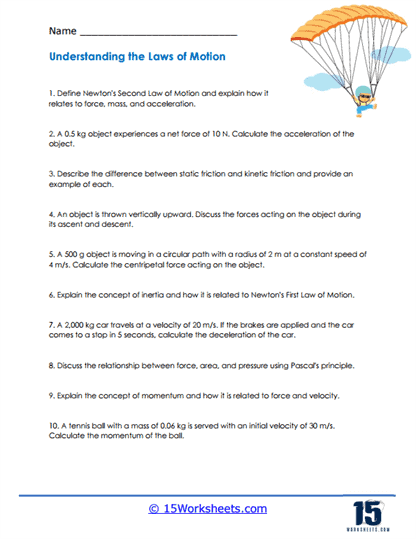Understanding the Laws of Motion

Worksheet Description
The worksheet offers an insightful exploration into the foundational concepts of physics, particularly Newton’s laws of motion, force interactions, and related phenomena such as friction, inertia, momentum, and centripetal force. It poses a blend of theoretical queries and practical problems, prompting students to both explain critical principles and apply them to solve real-world scenarios. By covering topics ranging from the relationship between force, mass, and acceleration, to understanding different types of friction, and calculating momentum, the worksheet provides a comprehensive overview of motion’s fundamental laws and their implications.
To adeptly navigate this worksheet, students should start by recalling and reviewing the basic principles of Newton’s laws of motion and the associated concepts. For theoretical questions, a clear understanding of the laws of motion, inertia, momentum, and Pascal’s principle will be crucial. For computational problems, students should utilize the relevant formulas, like F = ma for force-related calculations or p = mv for momentum, to derive the required values. Furthermore, a systematic approach, wherein students break down each problem step by step, will aid in obtaining accurate solutions and a better grasp of the underlying principles.
This worksheet aims to deepen students’ comprehension of the core tenets of motion in physics. It seeks to bridge the gap between theoretical knowledge and practical application, ensuring that students are not only versed in conceptual understanding but can also apply these principles to tangible situations. Through this exercise, learners are encouraged to think critically, analyze various scenarios, and utilize mathematical skills to deduce outcomes. In essence, the worksheet serves as a tool to reinforce foundational physics concepts, hone problem-solving abilities, and prepare students for more advanced studies in the subject.
